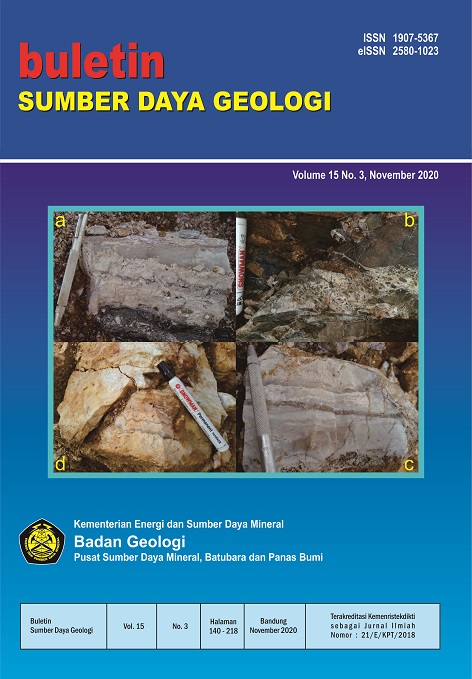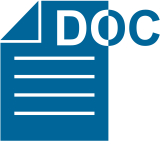IDENTIFIKASI ZONA MINERALISASI BIJIH BESI MENGGUNAKAN METODE POLARISASI TERINDUKSI DI DAERAH ULUSULITI DAN TANJUNG LIMA KAPAS, SOLOK SELATAN, SUMATRA BARAT
IDENTIFICATION OF IRON ORE MINERALIZATION ZONE USING INDUCED POLARIZATION METHOD AT ULUSULITI AND TANJUNG LIMA KAPAS AREA, SOUTHERN SOLOK, WEST SUMATRA
Abstrak
Daerah Ulusuliti dan Tanjung Lima Kapas, Kecamatan Koto Parik Gadang Diateh, Kabupaten Solok Selatan, Provinsi Sumatra Barat memiliki potensi bijih besi berupa zona mineralisasi yang terbentuk dari adanya batugamping yang diterobos batuan granodiorit. Pengukuran menggunakan metode polarisasi terinduksi dengan konfigurasi dipole-dipole dengan spasi antar elektroda 50 m. Data polarisasi terinduksi yang diukur sebanyak 11 lintasan dengan panjang masing-masing lintasan 1.200 m dan jarak antar lintasan 100 m hingga 300 m. Pemodelan 2D dilakukan untuk menghasilkan penampang resistivitas dan chargeabilitas dari setiap lintasan. Pemodelan 3D dilakukan untuk melihat persebaran zona mineralisasi bijih besi di daerah penelitian baik vertikal maupun horizontal. Pada model resistivitas dan chargeabilitas 2-dimensi, zona mineralisasi bijih besi diperkirakan memiliki nilai resistivitas >500 Ωm dan chargeabilitas >150 milisekon. Nilai-nilai tersebut diasosiasikan sebagai mineral-mineral bijih besi hasil dari alterasi hidrotermal yang terbentuk akibat adanya interaksi antara fluida magmatik dan meteorik yang berasal dari batuan granodiorit, kemudian fluida tersebut berinteraksi dengan batugamping. Hasil dari pemodelan 3-dimensi memperlihatkan kemenerusan zona mineralisasi relatif berarah baratdaya-timurlaut dengan volume sebesar 864.000 m3.
##plugins.generic.usageStats.downloads##
Referensi
Franklin, 2014, Prospek untuk Menentukan Wilayah Pengeboran Eksplorasi Logam Besi dan Logam Lainnya di Ulu Suliti dan Tanjung Lima Kapas, Kabupaten Solok Selatan, Provinsi Sumatra Barat, Pusat Sumber Daya Geologi, Bandung.
Gautama, I.F.Y., Heditama, D.M., Muttaqin, Y.A., 2018, Potensi Zona Urat Kuarsa Berdasarkan Analisis Geofisika dengan Metode Polarisasi Terinduksi di Daerah Olat Tanah Merah-Plampang, Kabupaten Sumbawa, Provinsi Nusa Tenggara Barat, Buletin Sumber Daya Geologi Volume 13 Nomor 1.
Heditama, D.M., Sunuhadi, D.N., Muksin, I., 2019, Pemutakhiran Data dan Neraca Sumber Daya Mineral, Pusat Sumber Daya Mineral Batubara dan Panas Bumi, Bandung.
Loke, M.H., 2004, Tutorial : 2-D and 3-D Electrical Imaging Surveys, Geotomo Software Malaysia.
Muttaqin, Y.A., 2014, Survei Polarisasi Terimbas (IP) dan Geomagnet Daerah Ulusuliti dan Tanjung Lima Kapas, Kabupaten Solok Selatan, Provinsi Sumatra Barat, Pusat Sumber Daya, Bandung.
Pirajno, F., 2009, Hydrothermal Processes and Mineral Systems, Springer – Geological Survey of Western Australia, Perth, Australia Barat.
Reynolds, J.M., 2011, An Introduction to Applied and Environmental Geophysics, Willey-Blackwell, Chichester.
Rosidi, H.M.D., Tjokrosapoetro, S., Pendowo, B., Gafoer, S., Suharsono, 1996, Peta Geologi Lembar Painan Sumatra, Pusat Penelitian dan Pengembangan Geologi, Bandung.
Supriyanto, 2007, Analisis Data Geofisika: Memahami Teori Inversi, Departemen Fisika, Fakultas Matematika dan Ilmu Pengetahuan Alam, Universitas Indonesia, Depok.
Telford, W. M., Geldart, L. P., dan Sheriff, E., 1990, Applied Geophysics, Cambridge University Press, Cambridge.
Van Bemmelen, R.W., 1949, The Geology of Indonesia, vol. 1A, General Geology of Indonesia and Adjacent Archipelagoes, ed. 2nd, Martinus Nijhoff, The Hague, Netherlands.
##submission.copyrightStatement##
##submission.license.cc.by-nc-sa4.footer##Penulis yang naskahnya diterbitkan menyetujui ketentuan sebagai berikut:
Hak publikasi atas semua materi naskah jurnal yang diterbitkan/dipublikasikan dalam situs Buletin Sumber Daya Geologi ini dipegang oleh dewan redaksi dengan sepengetahuan penulis (hak moral tetap milik penulis naskah).
Ketentuan legal formal untuk akses artikel digital jurnal elektronik ini tunduk pada ketentuan lisensi Creative Commons Attribution-ShareAlike (CC BY-SA), yang berarti Buletin Sumber Daya Geologi berhak menyimpan, mengalih media/format-kan, mengelola dalam bentuk pangkalan data (database), merawat, dan mempublikasikan artikel tanpa meminta izin dari Penulis selama tetap mencantumkan nama Penulis sebagai pemilik hak cipta.
Naskah yang diterbitkan/dipublikasikan secara cetak dan elektronik bersifat open access untuk tujuan pendidikan, penelitian, penyelidikan, dan perpustakaan. Selain tujuan tersebut, dewan redaksi tidak bertanggung jawab atas pelanggaran terhadap hukum hak cipta.















